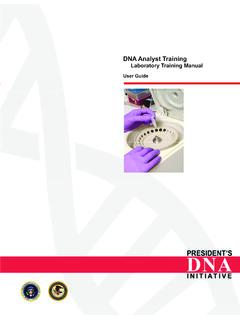Transcription of Basic Wine Training - tableside
1 tableside Hospitality Consulting Issue 1 Basic Wine Training 1 of 19 Basic Wine Training Introduction: A guest s dining experience is not complete without proper wine service. A server is not maximizing income opportunities without proper wine service skills. A meal is not truly complete without the accompaniment of wine. Proper wine service brands a restaurant and ensures repeat clientele and positive reputation. Guests will return often and recommend the place to their friends, thus causing the restaurant and the team members to prosper. Second, the sale of a glass or a bottle of wine adds to the guest s check thereby automatically increasing tips. Third, wine adds to the profit of the restaurant. Purpose: The information in this manual is intended to provide team members with the foundation on which they can develop wine confidence through knowledge.
2 This knowledge will not only benefit you as a food server, but will ultimately provide the team member with personal satisfaction as a consumer of wine. tableside Hospitality Consulting Issue 1 Basic Wine Training 2 of 19 Table of Content: Introduction:..1 Purpose:..1 Common Questions about Wine:..3 How Wine is Harvesting:..6 Crushing:..6 Fermentation:..6 Aging:..6 Racking:..6 Bottling:..6 How Champagne is Wine Appearance:..9 Aroma:..9 Taste:..9 Balance:..9 Finish:..10 How to read a wine Type of wine:..11 Vintage Date:..11 Winery Name and Location:..11 Geographic Designation:..12 Alcohol content:..12 How to sell Serving and Presentation of Temperature:..15 Timing:..15 Presentation:..16 Glossary of Wine tableside Hospitality Consulting Issue 1 Basic Wine Training 3 of 19 Common Questions about Wine: What is wine?
3 Wine is the pure, naturally fermented juice of ripe grapes or other fruits. In fermentation, yeast, which forms naturally on the grape and is most often added to the juice, converts the natural sugar of the juice into alcohol and carbon dioxide. Fermentation is stopped when the alcohol in the newly created wine reaches a level, typically above by volume, mortal to the yeast. When all the natural grape sugar is converted to alcohol, a wine is described as dry, once again typically over by volume. When a wine has residual or unfermented sugar still in solution it is described as sweet. The level of sweetness is determined by the percentage of residual sugar. What are the different categories of wine? Wine fits into the following categories: Table Wine: Red, White or Rose. Most have an alcohol content of below 14% and are made to accompany any food. Fortified /Dessert Wines: They have an alcohol content of 15% to 24% and have had neutral grape spirit added at some point during vinification.
4 Sparkling Wines: These wines contain carbon dioxide as a result of a second fermentation either in the bottle, Champagne most famously, or in large closed tanks, Asti, Prosecco, inexpensive brands. What gives wine its color? The juices of nearly all grapes are white; the color comes from the skins. Red Wine is fermented with the skins of the grapes, thus the natural pigment from the skin enters the wine and gives it the color. White Wine is fermented without the skins, which is removed right after crushing. Rose Wine is fermented with the skins for a short time and then the juice is drawn off to finish the fermentation alone. What is a varietal wine? In the United States, a varietal wine is labeled according to the predominant grape from which it is made. Examples of varietal grapes are: Chardonnay, Cabernet Sauvignon and Chenin Blanc. A varietal wine in the United States must be comprised of at least 75% of the grape stated on the label. In Europe, wines are normally not named after the grape variety, but rather after the region where the grape was grown.
5 tableside Hospitality Consulting Issue 1 Basic Wine Training 4 of 19 How is sweet wine made? There are two commonly encountered wines with sweetness, fortified and late harvested. Fortified wines, Port, Sherry and Madeira, plus a world of imitators, are produced by adding neutral grape spirit to a fermenting wine, thus raising the alcohol environment to a mortal level for the yeast. Port and some Madeiras are naturally sweet as the residual sugar comes only from the grapes while Sherry and some Madeiras are sweetened after being fermented to dryness by the addition of sweetening agents. Late harvested wines contain only natural residual sugar from the harvested grapes. Late harvested wines as the name suggests are produced from over-ripe, late picked grapes, most famously Sauternes from France or Beerenauslese from Germany. In the United States a wine labeled late harvest must state grape sugar at harvest and residual sugar in the finished wine.
6 Most late harvest wines contain 9-12% alcohol by volume. Fermentation is typically halted naturally as the sugar rich environment causes difficulty for the yeast. What is generic wine? American generic names like Burgundy, Rhine, and Sauterne came into use when European emigrants first made wine in this country and named them after areas from which the wine had similar characteristics. wineries prefer to use varietal labeling for their premium wines, specifying the grape variety used. What is tannin ? Tannin is an organic acid present in the grape skins and seeds, responsible for the astringent quality in a young wine. It is more pronounced in red wines because it is extracted from the skins during fermentation. The amount of tannin often relates to a wine s aging potential; it is deposited as sediment, along with other substances, as the wine ages in the bottle. Tannin is felt on the gum line, inside the cheeks, and when very powerful on the roof of the mouth and tongue.
7 It is the chewy, puckery, dusty quality in a red wine. Why are red wines generally enjoyed best at room temperature and white wines chilled? Bear in mind room temperature refers to a room s temperature prior to artificial environment. Lighter red wines are best served at 58-62 F while fuller reds are better at 62-65 F. White wines contain very little tannin and have a higher acidity than red wines. Chilling white wines brings out the fruity flavor of the wine, and makes the acidity more pronounced and the wines more enjoyable and refreshing. Be careful not to over chill, 46-48 F for Champagne and sparkling wines, 47-52 F for lighter whites, and 52-55 F for fuller whites. Always remember to ask the guest how they like the wine, as they are the final arbiter of proper service temperature. tableside Hospitality Consulting Issue 1 Basic Wine Training 5 of 19 Can wine that is served chilled be safely stored in the refrigerator?
8 Yes, but it is best to use the wine within one to two weeks to avoid harm to the cork. Once the wine is chilled it should not be stored again at room temperature. Why is it important to let red wines breathe ? Red table wines generally will benefit if uncorked and decanted then allowed standing at least 20 minutes before serving. Wine is a living body and when the bottle is decanted, the wine absorbs oxygen from the air. Simply removing the cork does little, as the dime sized surface area in the neck of the bottle is insufficient for oxidation. Oxidation activates the development of the bouquet and aroma and gives depth and smoothness to the wine. Older wine (20 years+) should be opened just before decanting and drinking. Why does one bottle of wine cost twice as much as another same size bottle of the same type of wine? The location, soil, drainage elevation, etc. where the grapes grow is probably the most important factor when producing quality grapes, which, with superior wine making skill produces great wine.
9 Great vineyards are a limited resource and therefore great grapes typically have a greater cost. Other factors could be that the wine may have been aged for many years in small casks to develop complexity or additional character. Supply and demand plays an important role in the determination of the value of a wine. What does vintage year mean? Since grapes are harvested every year, there is a vintage every year. An exceptional vintage is the result of a year of exceptional weather when all factors have been especially favorable. Why should some wines be decanted? Many old and increasingly younger red wines tend to throw sediment or a deposit. This can cloud the last few glasses poured from the bottle. This wine should be poured slowly and steadily into another container and stopped when the sediment is coming to the neck of the bottle. A light source, typically a candle though a pocket flashlight is acceptable, is placed below the bottle to allow a translucent view of the wine.
10 More importantly decanting allows contact with the air. This contact greatly benefits full flavored reds. tableside Hospitality Consulting Issue 1 Basic Wine Training 6 of 19 How Wine is made Harvesting: Most grapes ripen in late summer and early autumn. The earliest picking of wine grapes starts in the warmest regions in early August, but the main harvest, or vintage, comes in September and October. Frequent tests determine when to pick the grapes. This determination is predicated on sugar ripeness and increasingly over the last decade, flavorful ripeness and balance. As grapes mature, they gain in natural grape-sugar sweetness and decreasing fruit acidity. For wines in which tartness is desired the grapes may be picked earlier, while their fruit acid is still high. Crushing: Most quality wines are no longer de-stemmed and crushed. A more gentle process of juicing and whole berry fermentation is now employed most often, even the more thick-skinned varietals such and Cabernet Sauvignon and Syrah, receive gentle treatment.








